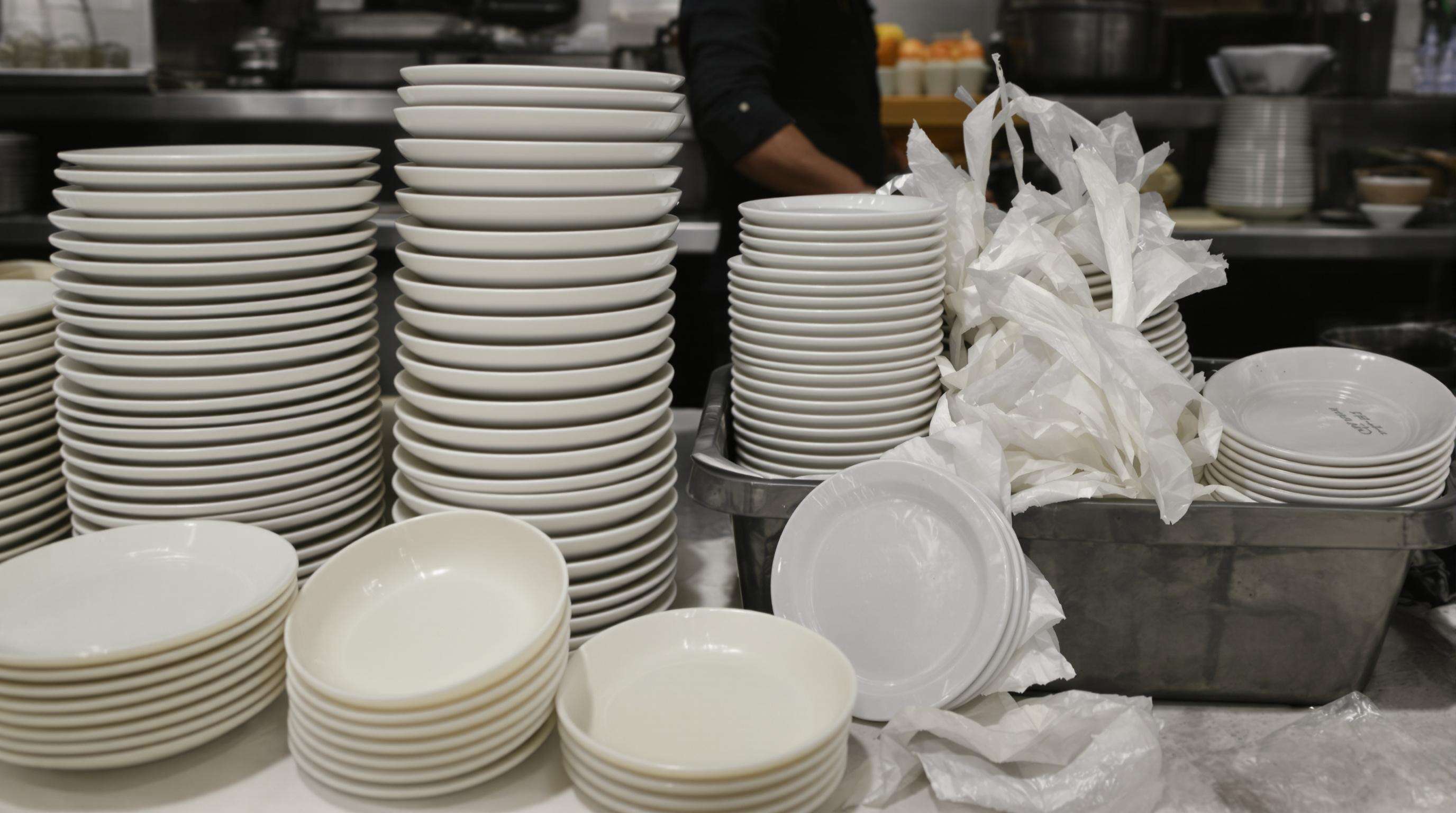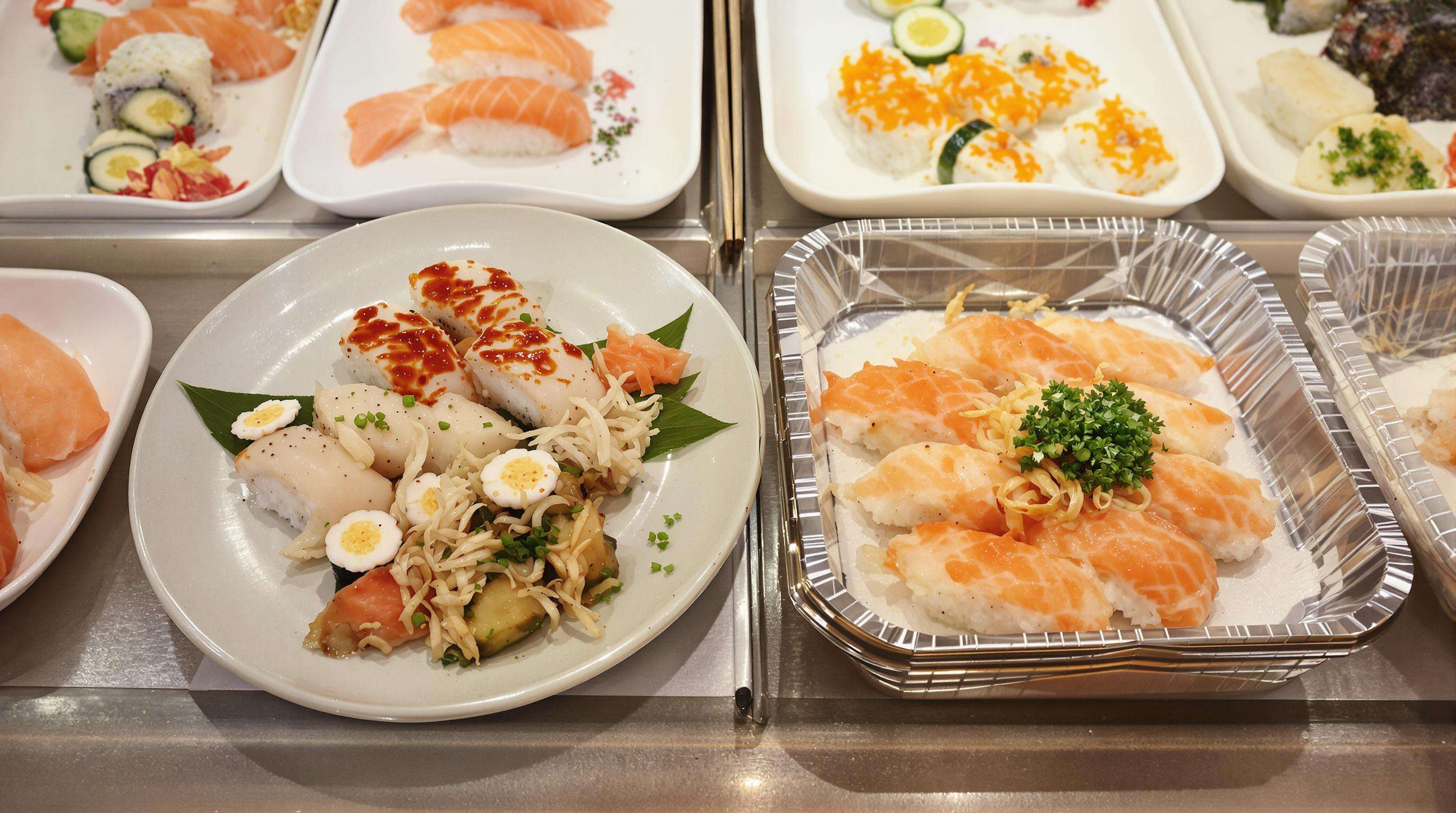Compact Ceramic Sushi Plate Packaging for Sushi Bar
Enhancing Sushi Presentation with Compact Ceramic Sushi Plates
How the Compact Ceramic Sushi Plate Enhances Visual Appeal
The Compact Ceramic Sushi Plate takes sushi presentation to another level with its clean lines and smooth texture. The shiny surface reflects light beautifully, making colors pop for things like bright red salmon roe and translucent tuna slices much better than those flimsy paper plates ever could. The plate's shallow edges let the nigiri stand out without getting lost in the background, plus everyone gets the same size so restaurants can plate everything consistently. Some folks actually did a study last year at a big cooking school and found something interesting too. Turns out around three quarters of customers snap pictures of their meals when they're served on ceramic plates, whereas only about one fifth bother with disposable ones. Makes sense really since good looking food just begs to be shared online these days.
Linking Plate Design to Customer Experience in Sushi Bars
Ceramic plates designed with care really make a difference in Japanese dining environments, improving both how the place looks and how it functions. The non porous surface stops sauces from spreading around, so chefs can keep their beautiful presentations intact when serving food. These plates usually weigh between 300 to 400 grams, which gives them that upscale feel many diners appreciate. People actually find these ceramic plates feel about four times more fancy compared to plastic ones according to some tests done in restaurants. Plus, the angular shapes take up less space on counters at small sushi bars, making life easier for staff. This means servers spend about 15 percent less time arranging dishes, allowing for smoother service during those special omakase experiences where the chef picks what gets served.
Data-Driven Insights: Diners’ Perception of Ceramic vs. Disposable Plates
What people think about their meal often starts with what's sitting under it. A recent study found that miso soup served on stoneware stays warm around 22 percent longer than on other materials, which makes all the difference in how good it tastes. Pretty interesting stuff. And here's something else worth noting: when sushi looks exactly the same but comes on ceramic versus plastic, nearly two thirds of customers believe the ingredients must be better quality. From an environmental standpoint, sushi spots in cities switching to reusable plates can cut down on garbage by almost 23 tons each year. That kind of green move tends to attract folks who care about sustainability, and those customers typically drop about 34 percent more per visit at places that prioritize eco-friendly practices.
Case Study: Premium Sushi Chain Upscales Brand Image with Ceramic Serveware
One major sushi restaurant chain based in Tokyo rolled out these special ceramic plates at their 12 different spots, and saw real improvements in both brand image and day-to-day operations within just three months. The plates had those nice little wave designs that really captured traditional Japanese aesthetics, and people started talking about them online much more than before. Social media mentions jumped by around 17%. Sure, buying all those custom ceramics cost about 45% more upfront compared to regular stuff, but they actually paid themselves back after 14 months because there were no longer any costs for disposable items. After making the change, customers gave the atmosphere an average rating of 9.1 out of 10, which was way better than before (about 38% improvement). This shows that when restaurants invest in good quality materials, it really enhances the overall dining experience for patrons.
Sustainability Benefits of Compact Ceramic Sushi Plate Usage

Reducing Waste with Reusable Ceramic Plates in Japanese Cuisine
Sushi packaging has become a major problem for landfills, especially at mid sized places where they throw away tons of those plastic containers every month. Enter the Compact Ceramic Sushi Plate, which actually lasts forever and can cut down on about 600 single use items each year for one restaurant alone. Restaurants save money because they don't have to keep buying new stuff, plus they're not adding to the mountain of trash piling up everywhere. And let's face it, nobody wants plastic waste seeping into rivers and oceans anyway. Plus ceramics won't leach harmful chemicals into our environment like some plastics do, so recycling them properly helps protect both wildlife and people in the long run.
Eco-Friendly and Sustainable Packaging in Japanese Cuisine: A Growing Trend
People want to eat sustainably these days, and numbers back this up. The latest Sustainable Packaging Report from 2024 says around 60 percent of folks actually care about where they dine if the place shows it takes environment seriously. Some top sushi spots in Tokyo have seen their customer count jump by about 30% since switching to regular ceramic dishes instead of disposable ones. These ceramic plates work great for sustainability because there's no need for all those plastics wraps, waxy coatings, or chemicals lining them. Plus, their classic look connects with something called mottainai, which is a traditional Japanese idea about not wasting things. This really clicks with customers who value such things, and these same people tend to post pictures of their meals on social media quite often too.
Environmental Commitment in Sushi Restaurants Through Material Choice
When restaurants go for ceramic instead of throwaway stuff, they're basically saying sustainability matters to them. Take plastic coated bamboo or those petroleum based packages versus ceramic made from plain old clay. The ceramic requires way less processing and actually cuts down on carbon emissions by around 40% when it's being produced. Plus, ceramic keeps heat better so there's no need to keep running the fridge all night long during dinner service. If taken care of right, these ceramic plates can stick around for generations, which means fewer resources get wasted over time. Restaurants that pick this route tend to start thinking greener overall too. They might begin buying locally grown food or figuring out ways to save power elsewhere in the kitchen. All these little changes build up into something bigger that tells customers this place really cares about going green.
Compact Ceramic Sushi Plate vs. Traditional Packaging: Performance and Cost

Material Durability and Long-Term Cost Efficiency
Ceramic sushi plates are actually better than those throwaway containers when it comes to lasting power and saving money. These little ceramic plates can handle being washed over and over again without chips or cracks forming, so there's no need to keep buying new ones every week. According to some restaurant owners I've talked to, most places start seeing real savings after about six months of using ceramics instead of disposables. Think about it this way: a typical sushi bar spends anywhere between 40 to 60 percent less on packaging costs over three years once they switch. What looks like a bigger upfront expense turns into serious cash saved down the road for operations managers who care about their bottom line.
Impact on Food Temperature and Freshness Retention
The density of ceramic materials makes them really good at keeping sushi fresh. Some research shows that ceramic trays keep fish at just the right temperature for about three times as long compared to plastic ones. What matters most is how ceramic doesn't react with food and won't absorb any moisture, which helps maintain the rice's perfect texture. Because of this property, both nigiri and sashimi stay fresher throughout service periods, sometimes lasting around 25% longer than when served on other surfaces. This extended freshness definitely impacts how the dish tastes and feels in the mouth, ultimately leading to better customer experiences at restaurants serving Japanese cuisine.
Design Innovation and Branding Opportunities with Ceramic Sushi Plates
Compact ceramic sushi plates merge functionality with brand storytelling, enabling sushi bars to elevate their identity, streamline service, and strengthen customer engagement.
Ergonomic Benefits of the Compact Ceramic Sushi Plate for Service Efficiency
Servers can easily handle several plates at once thanks to their tapered edges and well-balanced weight distribution, which really comes in handy when things get hectic in the dining room. A recent study from the National Restaurant Association found that these plates with their special glazed finish cut down on dropped items by around 42 percent compared to regular serving platters back in 2024. Plus, the way they stack on top of each other means restaurants need about half the storage space for them, making kitchen organization much simpler and keeping countertops from getting too crowded with extra dishes.
Customization Options for Branding in Sushi Presentation and Customer Experience
Sushi bars are increasingly using ceramic plates as canvases for brand expression through:
- Embossed logos: Subtle, dishwasher-resistant branding that reinforces identity
- Regional motifs: Hand-inspired designs reflecting local culture or sourcing origins
- Color gradients: Glaze variations that align with restaurant themes—such as oceanic blues for seafood-focused menus
A 2024 consumer survey on premium dining trends found that 78% of patrons associate customized serveware with higher food quality, underscoring its impact on perceived value, customer loyalty, and social media visibility.
Consumer Trends Driving Adoption of Compact Ceramic Sushi Plates in 2024
Rising Demand for Sustainable Dining Experiences
These days sustainability isn't just for tree huggers anymore. Studies show around two thirds of young adults under thirty five actually look for places to eat where they won't find single use plastics or paper products. That's where the Compact Ceramic Sushi Plate comes into play. Restaurants switching to these plates cut down on all that garbage piling up in landfills while also showing customers they care about the planet. When people walk into a place and see actual ceramic dishes instead of throw away stuff, it sends a message. And let's face it, when folks care about their carbon footprint, they tend to remember which restaurants align with their values. We've seen this happen time and again with our clients who made the switch to ceramic serveware last year. Their regulars keep coming back, and word spreads fast among friends who share similar concerns about waste.
The Influence of Social Media on Sushi Presentation and Customer Experience
Visual appeal directly influences restaurant popularity in the digital age. Sushi presented on elegant ceramic plates generates 50% more social media shares than when served on disposable packaging, according to culinary trend data. The refined aesthetic enhances perceived value, encourages customer engagement, and drives repeat visits through shareable dining moments.
Forecast: Shift from Single-Use to Permanent Serveware in Urban Sushi Bars
Sushi spots in cities are dealing with more rules about cutting down on packaging trash these days, plus customers want nicer looking places to eat. Some industry reports suggest around half of all sushi places in big cities might switch to using ceramic plates permanently within the next few years. Going this route saves money over time for sure, but it also helps restaurants stand out as eco-conscious innovators in the food scene. Many owners see it as smart business too since younger diners especially seem to appreciate when a place cares about sustainability.
FAQs
What are the main benefits of using compact ceramic sushi plates?
Compact ceramic sushi plates enhance visual appeal, increase brand recognition, improve customer experience, aid in sustainability by reducing waste, and provide long-term cost savings.
How do ceramic plates impact customer experience in sushi bars?
They elevate the dining experience by maintaining food aesthetics and temperature, which enhances taste and presentation. Moreover, they convey quality and sustainability, attracting more customers.
Are ceramic plates cost-effective for sushi restaurants?
While initially more costly, ceramic plates lead to cost savings over time by reducing the need for constantly buying disposable packaging and potentially attracting more eco-conscious diners.
How does the use of ceramic plates align with sustainability efforts?
Ceramic plates reduce reliance on single-use plastics, cutting down waste and carbon emissions. They support long-term use and can be recycled responsibly, leading to an eco-friendlier dining solution.
